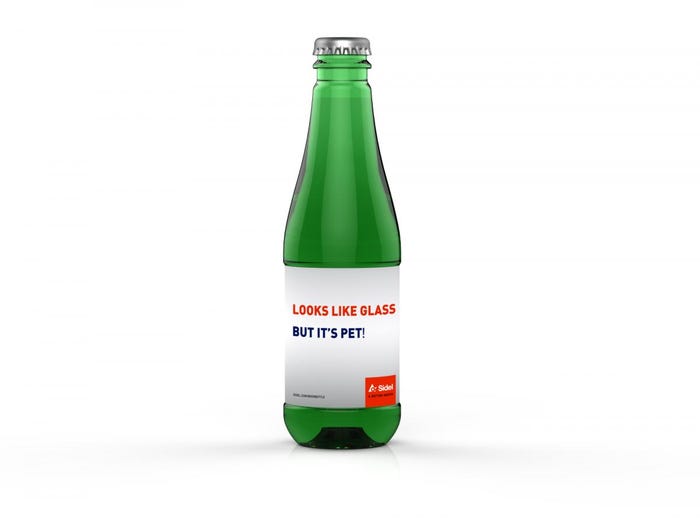It may look like glass, but packaging provider Sidel claims it's all PET. Sidel has launched what it calls the world's first-ever pasteurizable lightweight PET bottle for beer with a non-petaloid base. The bottle also supports a crown cap, which together with the non-petaloid base, gives the bottle the appearance of glass, but with all the advantages of PET. This includes the lightweight and increased mechanical properties of PET. The new bottle weighs about 28 grams, which is up to 86 percent less than an average equivalent glass bottle, according to Sidel data.
June 30, 2014
It may look like glass, but packaging provider Sidel claims it's all PET. Sidel has launched what it calls the world's first-ever pasteurizable lightweight PET bottle for beer with a non-petaloid base. The bottle also supports a crown cap, which together with the non-petaloid base, gives the bottle the appearance of glass, but with all the advantages of PET. This includes the lightweight and increased mechanical properties of PET. The new bottle weighs about 28 grams, which is up to 86 percent less than an average equivalent glass bottle, according to Sidel data.
 The relationship between PET and beer has been a slow one, to say the least. While around five billion PET packaging units of beer are currently sold a year, this is only about 2 percent of the global market, with glass and can being the most widely used materials. But Sidel claims that a slow adoption rate was also the case in the past with many other food and beverage products that have since increasingly made the switch to PET from other packaging materials, including juices, water, carbonated soft drinks, olive oil and sauces.
The relationship between PET and beer has been a slow one, to say the least. While around five billion PET packaging units of beer are currently sold a year, this is only about 2 percent of the global market, with glass and can being the most widely used materials. But Sidel claims that a slow adoption rate was also the case in the past with many other food and beverage products that have since increasingly made the switch to PET from other packaging materials, including juices, water, carbonated soft drinks, olive oil and sauces.
Now, to help beer producers and consumers alike make the same switch more easily, Sidel has created a PET bottle that utilizes a 'champagne' base that is more traditionally found on glass beer bottles. The bottle also supports a crown closure that again mirrors those more typically found on premium beer products.
To prove the benefits of its technology, Sidel has blown a 330 milliliter version that can achieve a six-month shelf life (with less than 1 parts-per-million (ppm) of oxygen ingress and less than 17 percent of carbon dioxide loss). The company can also provide versions up to 600 ML and is developing sizes even bigger. When packaging beer, it is critical to prevent oxygen entering and carbon dioxide escaping the package. The new bottle design can achieve this using single-layer material blends and Sidel's proprietary Actis gas-barrier technology.
The bottle can be used for flash or tunnel pasteurized beer, and also micro-filtrated beer. For tunnel-pasteurized beer, a PET bottle usually requires a petaloid base, but Sidel's new bottle has a unique base and other design technologies that mean it can resist the pressures produced by the prolonged high temperatures during this production process, while still retaining the appearance of a more traditional glass bottle. The bottle can withstand pressures of 20 pasteurization units (PU) in the tunnel, which is standard for lagers, and retains a stable base after pasteurization. Furthermore, the bottle design can be used on existing tunnel pasteurizers that currently serve glass bottles.
"We want to help beer producers take advantage of the flexibility, lighter weight, sustainability and lower costs offered by PET, by producing a bottle that was more attractive to the next generation of beer consumers who want their drinks packaging to be more sustainable, convenient and user-friendly," said Christophe Bunel, head of packaging care at Sidel. "For many consumers, a petaloid base is associated with other product categories, such as carbonated soft drinks or sparkling water, and therefore when it appears on a beer bottle it can negatively affect the brand perception. But increasingly consumers are becoming more aware of the benefits of PET, because they experience it as the preferred packaging material of choice in other food and beverage areas in their life. So to help producers and consumers alike make the transition we wanted a bottle that looked like glass, but has all the benefits of PET."
For many years there have been misperceptions around beer in PET. For example, some think beer in PET gets warmer quicker. In fact, in Sidel's studies, the PET beer bottle kept beer cold for the same time duration as an equivalent sized glass bottle. Taste is also another misperception, with some consumers believing beer tastes better, for example, in cans instead of PET bottles. The jury is still out on that one.
Sidel says the company is currently in conversations with some of the "world's leading, and most well-known," beer producers on how to bring PET to beer using its new bottle design and packaging technology.
About the Author(s)
You May Also Like


